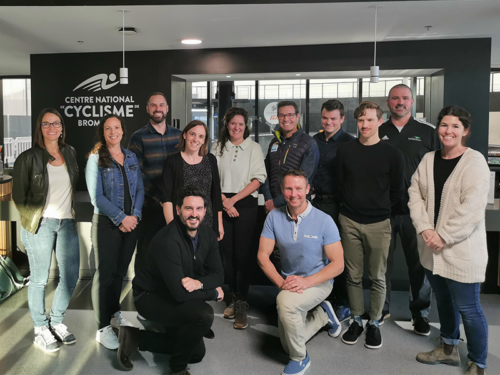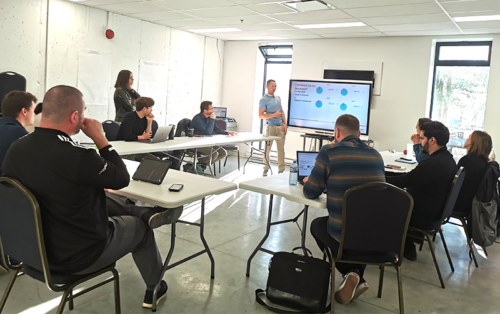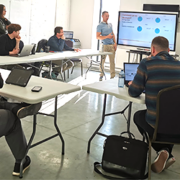Physical Literacy for Communities Initiative progressing successfully in Bromont, Quebec
 The Physical Literacy for Communities (PL4C) national initiative, which received support from the Public Health Agency of Canada in 2021 to expand the project to new communities, has been successfully implemented in Northern British Columbia, Alberta, Quebec, Nunavut and the Atlantic provinces. Led by Sport for Life, PL4C aims to support the development of physical literacy in 150,000 children and youth aged two to 18 across Canada.
The Physical Literacy for Communities (PL4C) national initiative, which received support from the Public Health Agency of Canada in 2021 to expand the project to new communities, has been successfully implemented in Northern British Columbia, Alberta, Quebec, Nunavut and the Atlantic provinces. Led by Sport for Life, PL4C aims to support the development of physical literacy in 150,000 children and youth aged two to 18 across Canada.
At the heart of this dynamic, Quebec is making notable advancements in Lanaudière, Bromont, and Kuujjuarapik. We had the opportunity to speak with Yannik Morin, PL4C associate mentor in Bromont, for an update on the project’s progress within the community.
Progress of the project
According to Morin, the PL4C initiative in Bromont is moving ahead smoothly so far.
“Everything is going well. We are where we should be, as we have identified the goals we wish to achieve. We have developed the structure, the brand, and the mission. Additionally, several committees have been established to advance these objectives,” Morin said.
Through their collaboration, Bromont’s community partner table realized they had a variety of sectors that their project could support such as education, health, leisure and sports, media, key performance indicators (KPIs), grant groups, representation, and guidance. To address the variety of interests and needs, the table has created eight distinct sub-groups from its partner organizations, including the guidance group responsible for setting milestones and monitoring progress, as well as the representation group empowered to convey the message to sponsors, organizations, and media during events. These individuals, all of which have a strong understanding of the project and extensive relationships, have also participated in webinars to deepen their understanding of physical literacy and group training methods.
“In the Bromont region and its surroundings, we have identified a crucial issue: key players such as parents, educators, and coaches are unaware of the importance of physical literacy as the foundation for an active life. All our initiatives aim to target these stakeholders and raise their awareness,” Morin emphasized.
To successfully accomplish their mission, the partner table has identified their most important goals, including developing physical literacy, reducing screen time exposure, preventing early specialization, promoting inclusion, and creating accessible environments. The table has come up with the following to address these areas: effective communication, education and awareness, positive role models, positive reinforcement, collective participation, and ongoing training. Their target audiences are parents, early childhood centers (CPE), schools, and sports clubs.
Website development
To support their project, Morin and his team have taken the initiative to design and develop a website to reach a wider audience, demystify the project’s benefits, and make Sport for Life’s resources accessible. 
“Physical literacy is a captivating concept; I haven’t met someone who isn’t interested in learning more about it yet. Our challenge is communicating our actions and goals clearly and concisely, using language that resonates with our target audience,” Morin explained. “We will add authentic testimonials to establish a sense of closeness and connection with our audience.”
The website will be more than a simple online platform–it will be the preferred access point for anyone wishing to discover, understand, and engage in community activities and physical literacy initiatives. By highlighting real stories, engaging videos, and educational resources, the website will create an immersive and informative online experience that sparks interest and mobilizes an engaged community around physical literacy and the enduring benefits of sport.
Projects for the coming year
The team in Bromont has also defined a series of ambitious objectives for the coming year, based around various key concepts including impactful communication that draws lessons from governmental s methods during the COVID-19 pandemic. Targeted education and tailored awareness will be implemented to address the specific needs of diverse populations, and the table intends to share testimonials, videos, and brochures highlighting individuals who are positive examples of physical literacy development. Formal recognition of parent, municipality, school, and early childhood education contributions will be established, with articles written and even honorary distinctions given out at an annual gala.
The team will also organize family events and annual meetings to strengthen their cohesive message. Stakeholder training and personal development will be encouraged, as well as evaluation and tracking to measure the effectiveness of the actions taken within their community.
“We need to assess the relevance of our actions. A subcommittee will evaluate our performances, the impact on young individuals using the PLAY Tools, the increase in multi-sport practices, etc.,” Morin said.
He also emphasized the partner table’s overall enthusiasm and determination for the project. For his team, the initiative stands out for its innovative and targeted approach, which actively engages stakeholders to promote physical literacy—a mission they are evidently keen to continue to foster and promote!
“We embody a true revolution in physical literacy, focusing on essential stakeholders. Our group is filled with energy and enthusiasm, driven by a strong vision.”
To learn more about the PL4C initiative, visit our dedicated webpage by clicking here.

